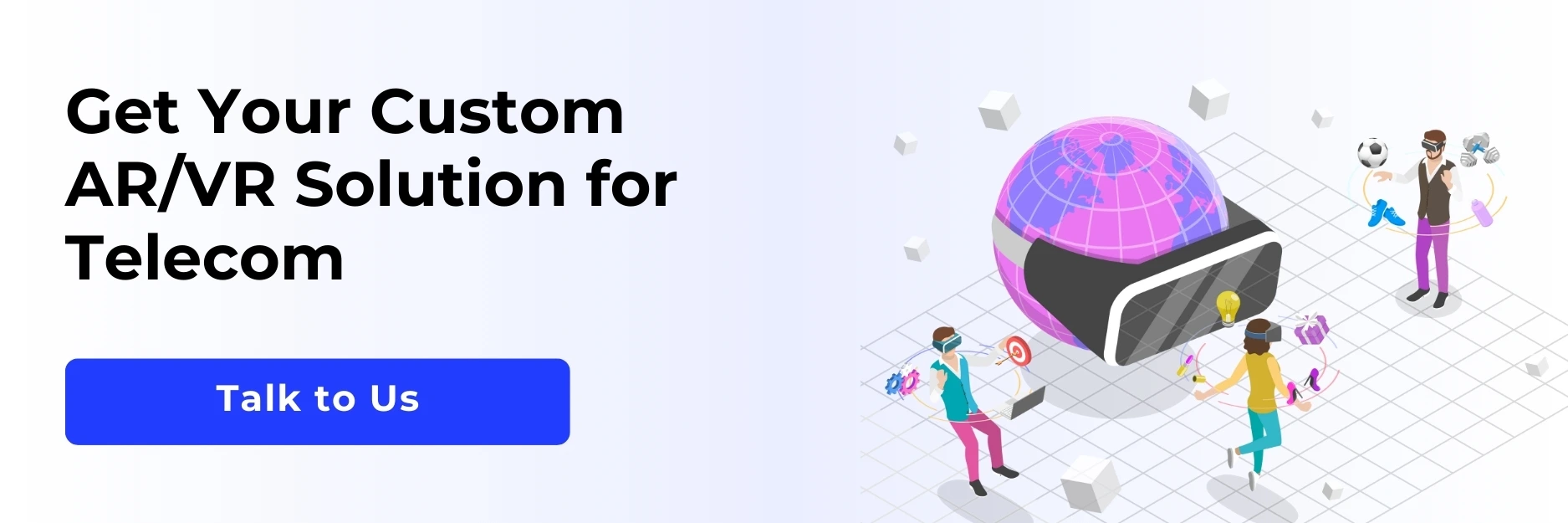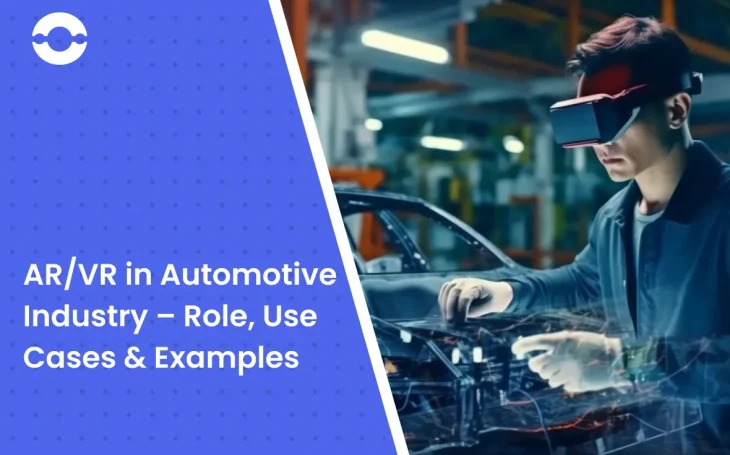
AR/VR in automotive industry is gradually becoming a staple due to the many use cases and benefits it offers to the sector. It simplifies and enhances vehicle purchasing and driving experience for the parties involved.
How great would it be to get how-to information for repairs, maintenance, and vehicle exterior and engine parts in an interactive way that can be displayed over the air and in real time? Or learn how to drive virtually?
This and much more is possible through immersive technologies called augmented reality or AR and virtual reality or VR.
Let’s see how AR/VR in the automotive sector improves the overall industry experience in this blog.
AR/VR in Automotive Industry
AR/VR in the automotive industry is rapidly being used to improve driving and traveling experience. In fact, among all the major sectors, the automotive sector accounted for the largest investment in AR and VR technologies.
Some of the industry leaders such as Porsche, Chrysler, Hyundai, Mitsubishi, and Tesla have already incorporated the two technologies in different stages of vehicle manufacturing, marketing, and sales.
The growing use of AR/VR in automotive industry could be attributed to the following factors:
- Adoption of modern technologies by vehicle manufacturers in multiple manufacturing pre- and post-sale stages.
- Ever-evolving safety standards and legalization inside the vehicle.
- The trending concept of connected cars.
- Quicker real-time data generation from ADAS (advanced driver assistance systems) focused on focused on collision avoidance technologies and driver aids such as night vision, adaptive cruise control, etc.
AR is used to design cars, test prototypes as well as train employees. VR, on the other hand, is used for marketing and advertising purposes such as creating virtual showrooms and test drives, among other roles.
For example, in case a check-light flashes on the driver’s dashboard, AR automotive original equipment manufacturer or OEM allows the driver to scan the barcode on the dashboard and identify what has gone wrong with the vehicle.
This way the driver simply ditches the traditional method of looking for a manual or a mechanic and detects the issue hassle-free. Since AR augments real-world experience with the usage of graphics and data, many traditional processes in the industry are being replaced with modern, easier ones.
The AR/VR market rapidly grew in the automotive industry and is expected to further expand in the coming years.
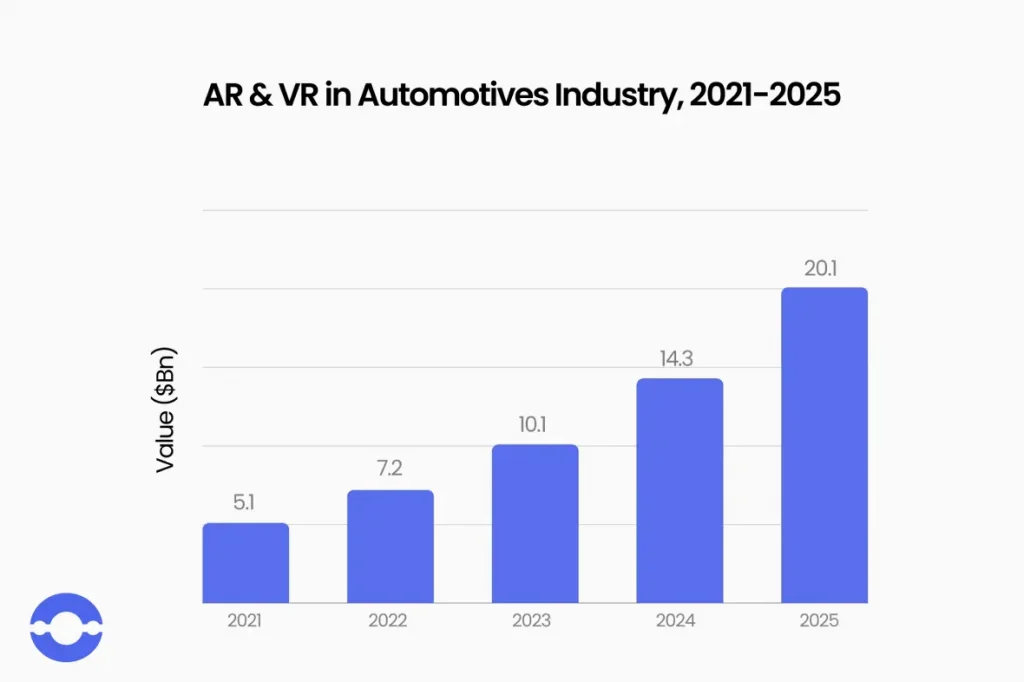
The AR/VR market in the automotive industry is expected to grow at a CAGR of 32%, between 2021- 2025.
The AR-based head-up display (HUD) segment has been projected to hold the largest share of AR & and VR in the Automotive market till 2026.
Furthermore, sensor fusion (the merging of data from at least two sensors) that ensures data accuracy and reliability for safety apps in cars, is known to be a key technology for semi-autonomous and autonomous vehicles.
Lastly, the rapid growth and adoption of modern displays such as AMOLED (active-matrix organic light-emitting diode) and OLED (organic light-emitting diode) displays can further drive AR/VR demand in the automotive industry.
Use Cases of AR/VR in Automotive Industry
The automotive industry has embraced modern solutions such as immersive technologies. Being actively adopted by multiple vehicle manufacturers and sellers, AR/VR has many use cases and benefits in the automotive sector.
From inventory, manufacturing, and marketing to maintenance and support, AR/VR applications are divided into many manufacturing and selling stages. These technologies enhance the overall vehicle production and driving experience.
Let’s look at the various AR/VR use cases in the automotive industry.
1. Designing and Prototyping
Traditional physical prototyping and design iterations could be time-consuming and costly. Hence, AR/VR in automotive industry is being used very smartly and creatively in designing, prototyping, and other processes. Some automakers are leveraging the immersive technology of VR to view the vehicle from different perspectives including that of a person shorter and taller than average. This allows them to understand different points of view and design accordingly.
Furthermore, designers can get multiple design options, and adjust the vehicle design by leveraging projectors that overlay relevant AR images on actual vehicle models. AR can also be used to create a collaborative working environment for different participants.
Similarly, virtual prototypes created using VR help automotive companies save time and costs whilst ensuring passenger safety. A digital twin of a vehicle could be created. This digital twin helps in making easy changes, or modifications to the concept, and design as well as reducing the development costs.
Moreover, with the help of a VR concept vehicle, auto developers can conceptualize the end product better before the finalization of the product model.
BMW leverages AR/VR in automotive industry at the designing stage to see and evaluate prototypes prior to finalizing the production version of a specific model. This ensures that all the latest international norms are abided by the vehicle as well as speeds up the entire launch process of the vehicle.
Virtual prototyping is especially beneficial in the case of electric vehicles (EVs). It enables the makers to test a new car’s entire system without the help of real hardware.
2. Virtual Showrooms
Customer engagement and involvement in traditional, physical showrooms could be limited due to multip0le factors such as model unavailability, staff shortages, etc.
However, with the help of AR/VR, automotive companies can offer to showcase the vehicles virtually to their customers. This allows the latter to enjoy viewing their dream cars from the comforts of their homes and facilitate a longer and stronger customer engagement.
Virtual showrooms help vehicle sellers and buyers overcome the issue of few models on display in physical showrooms, lack of color, and feature options.
With realistic 3D visualizations, customers can interact with the vehicle with the help of visual and physical mock-ups. Using an AR-based app for smart devices, almost everything from the vehicle’s color to the wheel design can be customized. AR/VR facilitates easy customization as well as interior or exterior upgrades. It almost feels like designing an avatar in a virtual game.
Customers can view all the changes or modifications and visualize every detail in real-time. This allows them to make more informed and conscious decisions.
KIA, a South Korean multinational automobile manufacturer, for instance, launched a VR showroom. The models of new vehicles were showcased to customers through this showroom, allowing for a more immersive experience.
Another example could be Renault Virtual Studio. It is a virtual showroom that allows customers to view their virtual vehicles even remotely using the internet. Customers get the 360° view of the vehicle which allows them to see details and customize the features as well as the accessories.
Customers can also take these models for test drives virtually or remote virtual tours.
Abarth offered potential buyers Bose headphones and a Virtual Reality headset that introduced them to the concept of VR test driving while sitting at home or on the go.
BMW also has an app that allows customers to experience and test the BMW 7 Series models. This app also includes informative videos and interactive images to highlight the vehicle’s potential. From opening the doors, and turning on the radio, to checking the internal parts of the car virtually, customers can experience the entire car like never before.
While virtual showrooms allow customers to participate in the designing process and enhance their overall experience, it also results in higher conversion rates for automotive companies.
Also read: AR/VR in Aerospace
3. AR Car Manuals
AR car manuals are a boon for both technicians and drivers. In case of any technical issue reflecting on the vehicle’s dashboard, the driver could simply detect it using AR. By scanning the barcode on the dashboard, the driver could get an explanation of what has possibly gone wrong.
Interactive manuals offer step-by-step guidance and video assistance that make it easier for the driver to identify and mitigate the issue. The traditional method of referring to the physical manual might not be possible every time; it might not be available at that moment or might not be comprehensive enough.
Similarly, AR is also used as an app or virtual assistant to assist with basic troubleshooting and repair. This could be used in showrooms, by salespersons, or by customers. These AR-powered auto manuals allow for cost-efficient demonstrations, especially in showrooms.
Hyundai came out with its first AR-powered virtual guide that recognized around 50 vehicle features of the 2015 and 2016 Sonata. Currently, it supports Genesis luxury sedans that use AR.
This guide offers how-to information for repairs, and maintenance, as well as for the vehicle’s exterior and engine parts. In–depth information related to particular parts is delivered through 2D and 3D tracking technologies.
Repair companies have started to increasingly incorporate AR to make their customer’s experience simpler, informative, immersive, and engaging.
NAPA is an automotive company that intends to offer motor vehicle repair services online and on virtual reality platforms. In fact, in 2022, NAPA (National Automotive Parts Association), applied to the U.S. Patent and Trademark Office to trademark goods and services that included “virtual and digital goods for use online and in, metaverse(s), online worlds, or other virtual reality platforms.”
Technicians can easily detect issues, their potential causes, or parts/equipment that need attention or repair. Then the interactive mauls can aid the repair work, eliminating the need to go through long hours of training. This also improved the quality of work done, reducing the number of hours taken and the costs invested.
Moreover, an auto manufacturer or an expert could also remotely communicate visual instructions to field technicians using AR glasses, thus facilitating better collaboration and work accuracy. AR enables a more effective, and productive diagnosis and repair process.
Porsche, an industry behemoth, has increased the applications of AR/VR in their workshops to address multiple technical issues with consistent results.
Engineers could make use of VR glasses to reach out to experts for assistance. Similarly, the maintenance staff could make improved decisions by consulting with inexperienced technicians.
4. Virtual Driving Lessons
VR driving simulators are rapidly being adopted by many companies or organizations in order to reduce the number of mishaps or accidents on the roads.
Using VR in driving lessons allows new drivers to gain a more immersive and realistic learning experience. This better educates them about road safety precautions and prepares them for the actual roads and traffic congestion, unlike the traditional driving lessons.
VR simulators come with huge computer monitors, a steering wheel, and seats to provide a similar experience of driving in different situations. For example, what would happen if the driver is distracted while driving? The consequences of such behavior could be identified without putting the driver in an actual dangerous situation.
Teen Drive 365 by Toyota and Oculus is an app that allows people to get an immersive experience while driving a car and interacting with the surroundings within the VR simulator. This system helps people to get educated on the ways to deal with road conditions and situations including noise, pedestrians, and traffic.
Similarly, Apple developed a VR car driving simulator app that simulates real-world experiences for driving with road bumps, sharp turns, and other hiccups that are faced by a driver.
It is compatible with VR cardboard and other VR headsets in the marketplace. This helps a driver identify and understand multiple situations and better prepare himself/herself. The app also makes learning more realistic by providing a dashboard on the screen.
VR could also help train novices to be alert and practiced enough to identify potential road risks and avoid them. People not been able to pass their driving tests even on multiple attempts could use the VR driving test to get better prepared for their next attempt.
Goodyear, for instance, offers a VR driving academy app as a part of their driver training program. The learner is given different driving situations to choose from and tackle with distractions. This app has also been adopted by the Driving Instructors Association or the DIA.
5. Heads Up Display (HUD)
A modern driver assistance system, Heads Up Display (HUD) projects real-time information or data on the windshield in order to keep the driver focused on the road. This information includes engine check light, vehicle speed, navigation, warning signals, etc.
This feature is mostly offered in the top models of vehicles. Most of the latest car launches have preinstalled HUD. In 2021, Audi announced its plan to launch an electric luxury SUV AUDI Q5 with an AR-enabled HUD system with a flying arrow that will be part of the navigation system.
Similarly, Maruti Suzuki launched its new product, the Brezza car, with a pre-installed heads-up display in 2022.
Mercedes-Benz also uses this technology for its different class series such as E, A, and S. In fact, its recent launch, the 2022 Mercedes-Benz EQS comes with HUD. The technology facilitates turn-by-turn navigation by projecting 3D direction arrows in the field of vision of the driver.
BMW also leveraged this technology in around 10 of its cars.
This technology also displays traffic and weather information and offers navigation support. This technology facilitates the development of smarter and safer vehicles. It also provides critical performance alerts for enhanced driving experience and safety.
6. VR Testing for Autonomous Vehicles
Presently, no autonomous vehicle without a person driving and ensuring the safety of other drivers and pedestrians, can be tested on the roads. However, using VR integrated with testing software makes it possible to test driverless vehicles.
In self-driven cars based on VR technology, the traffic simulation feature provides complete safety for the vehicle as well as the virtual environment created allows the vehicle to make mistakes and be reprogrammed to avoid them in the real world.
This also allows vehicle manufacturers to test their cars for different terrains, without getting affected by actual weather or road conditions.
7. Employee Training
AR/VR in automotive industry is also being used to train engineers and employees. Using an observation-based approach, most automotive manufacturers train their employees to assemble a specific car model. Afterward, these workers are given theoretical knowledge and made to assist experts in on-the-job training.
The latter stage is prone to errors and mistakes by the workers or engineers and as a result, damage to the final product. This is where virtual reality comes in and saves the day for all. It allows all the participants to work on-site or at a plant to learn and make mistakes virtually. This way the final product remains intact.
Additionally, working with heavy parts such as engines, axils, etc., for the first time could be dangerous. But with virtual platforms, this danger is eliminated, and learning is imparted; ensuring the safety of the workers/engineers.
For example, if virtual reality is used to train operators, the requirement for additional machines is eliminated. Moreover, removing the actual parts, and preparing knowledge could be gained through simulations.
This also ensures overall safety as no parts are being wrongly removed or inserted by new workers during training which could lead to accidents in the future.
Thus, with virtual reality, professionals/workers/engineers/designers are managed, directed, and monitored in a controlled environment making the entire training process more productive, efficient, and safe.
BMW included employee VR training while preparing their employees to deal with customers.
- AR/VR for Marketing and Advertising
AR/VR in automotive industry is a highly appreciated and applied technology. From designing and prototyping, to repair and maintenance, AR/VR enhances many manufacturing, development, and driving stages of a vehicle.
The above use cases such as virtual showrooms, driving lessons, AR car manuals, etc., are some of the key use cases or the role of AR/VR in the automotive industry. AR/VR is also used for entertainment purposes during rides. Audi, for example, introduced Holoride, the VR technology that allows passengers to entertain themselves during long rides.
Volkswagen, on the other hand, designed a VR digital room for all employees collaborating on a project, even remotely, to meet, interact, and discuss collective efforts. This improved project coordination and productivity.
While Lamborghini leveraged VR for advertising purposes. It came out with a heart-warming Christmas ad that used VR technology to reach out to the masses and allow them to feel the emotion for what it was.
A father in the ad wore a VR headset and experienced a virtual test drive his son came rushing to him in the new Lamborghini. The ad showed how distance can never make a difference between families.
Similarly, Porsche launched virtual influencers on platforms such as TikTok and Instagram to highlight the benefits and promote the appeal of their sports cars.
Conclusion
There are multiple present and potential use cases and AR/VR in the automotive industry examples that highlight the expanding role of these immersive technologies in the sector.
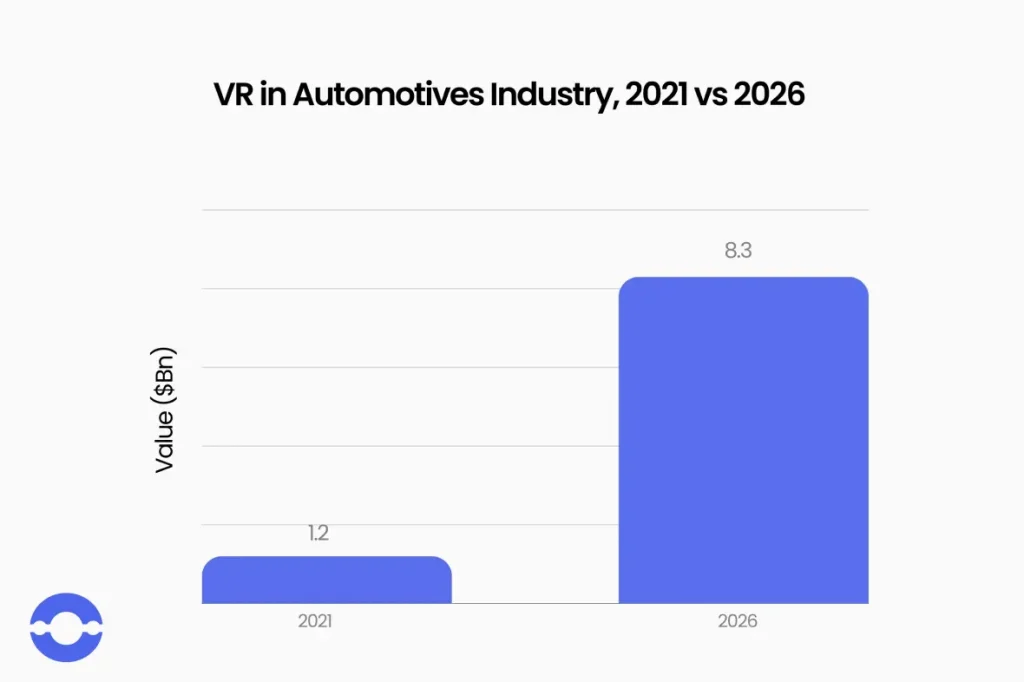
The VR technology in the automotive industry has been expected to grow at a CAGR of 38.03%, between 2022 – 2026
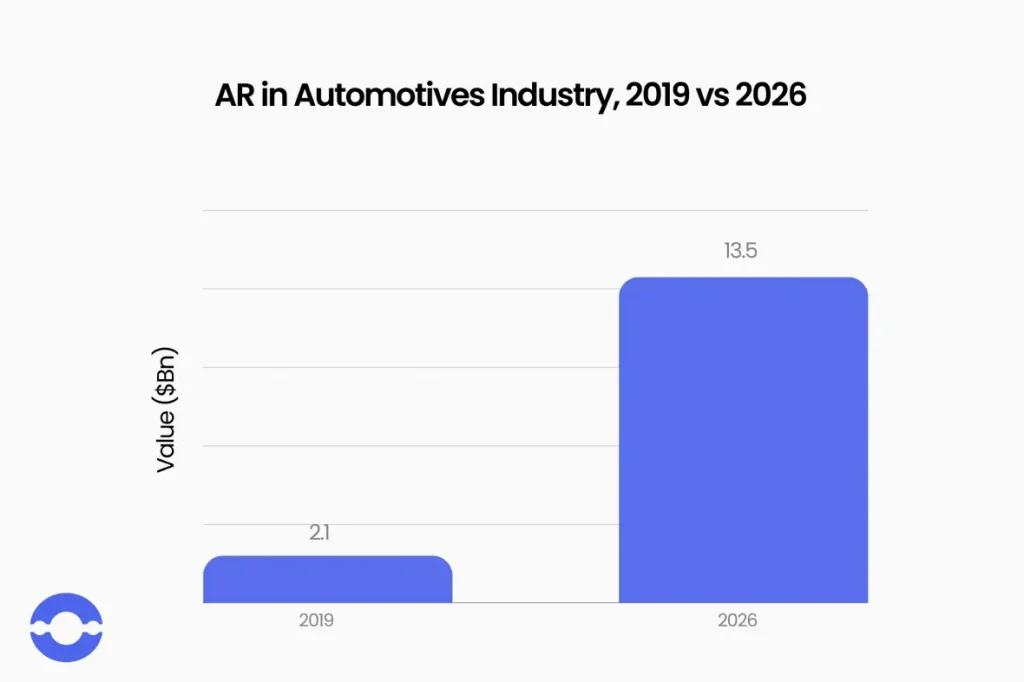
The AR market in automotive industry has been expected to grow at a CAGR of 36.31%, between 2020 -2026
Presently, big industry leaders are investing in these immersive technologies that explain their expanded market share in the sector. As these companies lead by example, more and more businesses in the industry are exploring and investing in these technologies, further reiterating their importance and role in the automotive sector.
And we certainly do not want you to miss out on the benefits of AR/VR technology and lag behind in the highly competitive automotive sphere.
Thus, we introduce you to BigOhTech end-to-end AR/VR app development services for the automotive industry.
From consultation, ideation, and design to development, testing, and maintenance, we ensure to build the perfect app for all your business and customer’s needs.
We specialize in sensor-based AR/VR desktop and mobile apps, location-based apps, visual, facial, and gesture recognition platforms, IoT-integrated AR/VR apps, etc., to help automotive businesses cater to the customers of the digital era.
BigOhTech helped a leading name in the industry to incorporate the 360-degree views feature in the mobile and desktop app to offer customers a clear interior and exterior virtual
view of the vehicle from different angles.
So, get in touch with us today to transform your customer experience!



